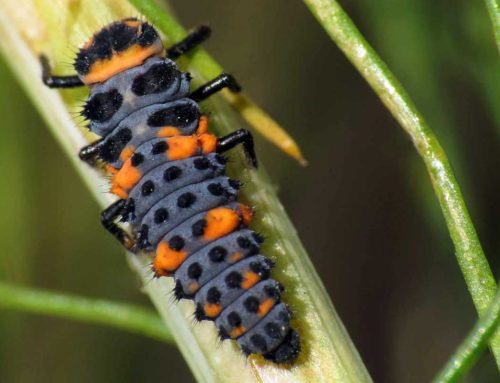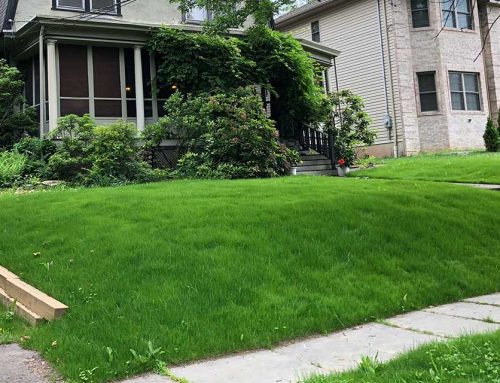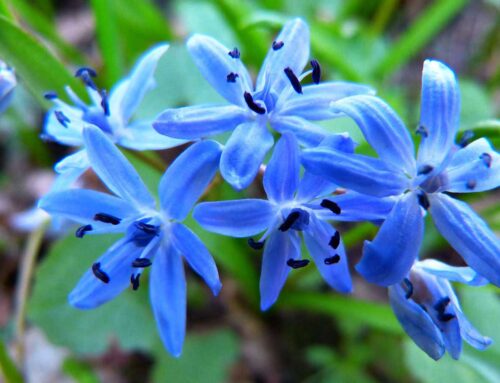Sustainability – Sustainable Landscaping
Going green in your yard means a lot more than the color of your lawn. In fact, you may not always want your lawn to look so green! Check out these ideas to green your landscape in healthy, sustainable, environmentally friendly ways.
What IS Green Landscaping?
Green landscaping — also known as sustainable or eco-landscaping — is a method to design, create, and maintain your landscape to save time, money, and energy. Green landscapes nurture wildlife; reduce air, soil, and water pollution; and make healthy recreation spaces.
Your yard can make a difference!
Why is this so important, you may ask, in the context of so many larger issues? Well, our “traditional” default landscape practices act as a metaphor for all of our other ecocidal, genocidal, and wasteful aspects of human society, those which, if not changed, will eventually lead to our downfall. Traditional landscape practices eschew diversity in the landscape for a limited and unsustainable palette of species, wiping out anything that might interfere with that goal via chemical and fossil fueled maintenance practices. Furthermore, like homogenized corporate culture, the ‘traditional’ landscape tosses out any sensibility or context of local adaptation or indigenous ecology, attempting to foist a “one size fits all” approach to everything, to the exclusion of everything else.
 Which is why we see the turf lawn used from sea to shining sea, from the boreal forests of northern Maine to the desert landscapes of southern California. And finally, last but not least, the traditional landscape fosters an extreme dependence on huge chemical inputs, fossil fuels, labor and materials that should seriously be questioned on a planet that is rapidly bumping up against its physical and ecological limits.
Which is why we see the turf lawn used from sea to shining sea, from the boreal forests of northern Maine to the desert landscapes of southern California. And finally, last but not least, the traditional landscape fosters an extreme dependence on huge chemical inputs, fossil fuels, labor and materials that should seriously be questioned on a planet that is rapidly bumping up against its physical and ecological limits.
This toxic, expensive and unsustainable model is heavily promoted in advertising on the corporate media in early spring, much of which consists of greenwashing and catchy phrases, such as Tru Green (formerly Chemlawn) urging “people to go greener” while ridiculing small local landscape maintenance companies.
Fortunately, sustainable landscaping provides an excellent alternative to these practices. What is sustainable landscaping? In a nutshell, sustainable landscaping eliminates or greatly reduces the wasteful and excessive use of fossil fuels or water in the landscape, promotes to as great an extent possible a diverse and rich community of plants with multiple layering in the ground plane and above, uses native or locally adapted non-invasive plants, makes use of local rainfall and runoff and absorbs it in place, and considers the need for providing habitat for native animal life, including the insects that provide the building blocks and foodstuffs for birds, mammals, and other animals that depend upon them.
A sustainable landscape has the following characteristics :
- Minimizes or mitigates impervious (water-repelling) surfaces so as to preserve the natural hydrologic cycle and replenish groundwater.
- Incorporates water-absorbent features such as rain gardens, green roofs and bio swales to soak in and recharge the water table.
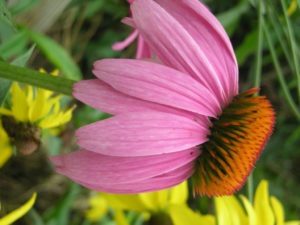 Utilizes long-lived locally native or non-invasive plants as the central element of the landscape.
Utilizes long-lived locally native or non-invasive plants as the central element of the landscape.- Minimizes or eliminates fossil fuel inputs for construction and management.
- Minimizes or eliminates inputs of man-made chemical fertilizers
- Reduces or eliminates artificial irrigation.
- Puts the right plant in the right place, by adapting the plant to the characteristics of the space versus the other way around.
- Maintains plants according to ecological principles and natural growth forms of the plant.
- Promotes biodiversity and habitat for other organisms, diversity makes a more resilient habitat.
- A sustainable landscape is a net carbon sink when factoring in maintenance practices and actually sequesters carbon.
- Uses locally sourced materials for plants and hardscapes (stone, paving materials).
- Recycles or reuses materials when practical.
- Modeled on local ecosystem processes and mimics the life and nutrient cycling found in stable natural areas.
- Integrates food production into the landscape and principles of permaculture.
- Builds soil structure, not degrades it.
In future diaries, I will flesh out these points as part of a series, discussing these elements one by one; however here are some tantalizing tidbits to explain some of the benefits of native landscaping.
A landscape based on a small palette of non-native species supports less than 10% of the insect species needed to sustain native birds (Bringing Nature Home). Replacing these landscapes with a diversity of native trees, shrubs, grasses and wildflowers supports the hundreds of species of native insects needed to sustain birds and other organisms such as frogs, toads, lizards, and bats, which help control annoying or dangerous insects such as flies and mosquitoes. It also links together an increasingly fragmented landscape that isolates natural areas between areas of biological desert.
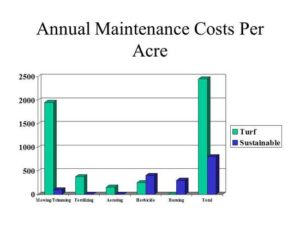 The typical home or commercial built landscape has less than 15 species of plants in an average 1-acre lot or commercial space. The average undisturbed forested, savanna or prairie landscape contains upwards of 100 species in the same area. Native prairie can contain 30 species in a square meter. Research has demonstrated that diverse plantings produce more biomass, store more carbon, and are more resistant to weeds and invasive species. That experience bears out in my home landscape as well, in a mostly native area that contains 40 species in a 25 x 15 area. A typical home landscape might contain 2 to 10 intentionally planted species, and several weeds or opportunistic plants. Almost no weeding is necessary, the diverse plantings and deep rooted prairie plants shut out typical lawn weeds such as dandelions.
The typical home or commercial built landscape has less than 15 species of plants in an average 1-acre lot or commercial space. The average undisturbed forested, savanna or prairie landscape contains upwards of 100 species in the same area. Native prairie can contain 30 species in a square meter. Research has demonstrated that diverse plantings produce more biomass, store more carbon, and are more resistant to weeds and invasive species. That experience bears out in my home landscape as well, in a mostly native area that contains 40 species in a 25 x 15 area. A typical home landscape might contain 2 to 10 intentionally planted species, and several weeds or opportunistic plants. Almost no weeding is necessary, the diverse plantings and deep rooted prairie plants shut out typical lawn weeds such as dandelions.
When the life cycle costs and embodied energy of traditional turf-centric landscaping maintenance equipment, fossil fuel consumption, and energy inputs of fertilizer, water, and machinery are factored in, the typical suburban lawn adds a considerable amount of carbon dioxide to the atmosphere, contributing to the greenhouse effect. Even the American Society of Landscape Architects has attempted to summarize the greenhouse gas effect of the dominant simplified lawn model of landscaping. 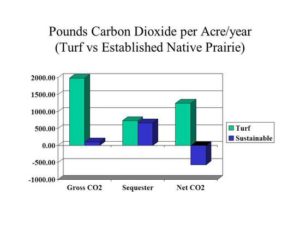 Replacing a turf-based landscape with a sustainable native –based prairie landscape actually reduces a positive carbon dioxide output of over 1/2 ton per acre to a net sequestration of 1/2 ton per acre per year.
Replacing a turf-based landscape with a sustainable native –based prairie landscape actually reduces a positive carbon dioxide output of over 1/2 ton per acre to a net sequestration of 1/2 ton per acre per year.
Sustainable landscapes celebrate the locality of place through locally sourced hard elements (stones and other hard features), and locally grown and obtained plant species. This specialness of place was called the “genius loci” by the Greeks and is an important element of the sustainable landscape.
The locally sourced materials also require far fewer energy inputs to obtain and decrease the chance of importing disease and invasive species into the area. Locally grown and propagated plants are also better adapted to the local climactic conditions.
Content provided accredited to “NO MORE LIES”
Lincoln Landscaping “The Natural Choice”
Mike Kolenut President & CEO
AN ACCREDITED ORGANIC LAND CARE PROFESSIONAL
https://lincolnlandscapinginc.com
(201) 848-9699


